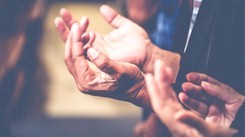
His overarching message:
overwhelm bad with good.
Don’t
get distracted by the crazy things that go on in this world. Keep working at the
activities that generate
good.
At this point, it was time for the
concluding round of
prayers. I knew
from past experience
that these involved a variety of actions in quick succession, including
forms
of sitting, kneeling, and prostration that my knees really aren’t
suited
to.
As we all stood, a man in the row just in front
of me moved aside, and with a welcoming gesture, offered me a space
alongside
him. I thanked him,
but explained that I
had knee problems. He
replied that what
I should do then was take a seat among a small number of folding chairs
that
had been set aside. I told him I didn’t want to
take up a seat
when there were only a few of them, and other people undoubtedly needed
them
more than I did. I’d
be fine standing in
the very back.
He pointed out that there were still
a number of empty seats. Seeing
that he was right, I went over and, somewhat
sheepishly, took one of them.
I was soon glad that I did. Being in close to everyone
else, I was able to
participate in ways that I felt comfortable doing, rather than simply
observing
everything from a distance. Like
the other
guys around me, I never knelt or did a full-on prostration, but I could
at
least sit in a chair and lean far forward as they did, and stand when
they did,
and most important of all, participate in and experience the shared
energy of
the group—which turned out to be considerable.
As we went through a series of prayers and their
accompanying physical
positions, I had a strong feeling that at that moment, everyone one in
the room
was focused on being the best person they could be.
By the prayers’ end, a palpable
feeling of warmth and
positive connectedness filled the room, as people shook hands with
those near
them. I’d been in
church services where
the attendees were urged by their clergy to do something similar, but
these
attempts had always seemed awkward and contrived.
Here, the handshakes felt sincere and
entirely natural.


